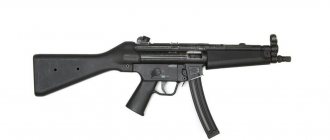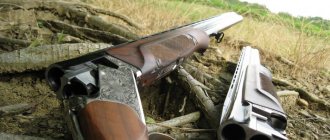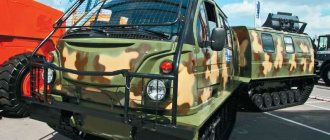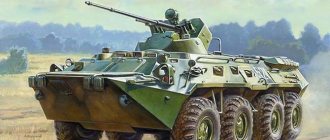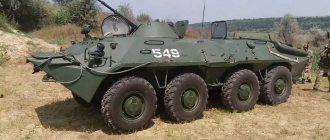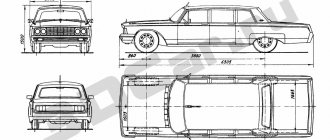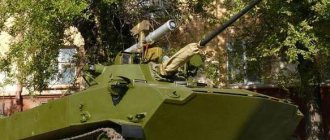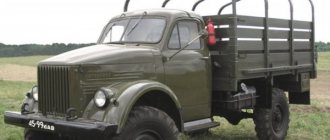The PTS-2 floating transporter belongs to the category of domestic tracked military equipment, designed to transport combat units through water obstacles. During the Second World War, the USSR army was in dire need of self-propelled transport devices. A small part of the needs was covered with the help of Lend-Lease. Nevertheless, after the end of the war, it was decided to create our own designs of a similar configuration.
Prototypes
One of the ancestors of the floating transporter PTS-2 was a tracked modification of the K-61 type. Its development was carried out in 1948. The engineering design bureau was involved in this project using parts of the M2 combat tractor. Mass production began at the plant in Kryukov (until 1958). Further production was established at the Izhevsk enterprise “Stroymashina”.
The floating unit was equipped with a solid supporting body made of metal that did not allow water to pass through. Loading and unloading operations were carried out using a special winch located in the bow section. The equipment had a drop-down side at the rear, equipped with entry skis (ramps). The YaAZ-204V diesel unit with a power of 130 horsepower was located in the middle, providing the equipment with decent trims when moving afloat in a loaded or empty state.
In one trip, the K-61 is able to transport up to eight wounded soldiers on stretchers, 40 soldiers in full equipment, trucks (one at a time), a 100 mm gun, and a 160 mm mortar. A pair of screws located in the tunnel part of the bottom of the hull acted as liquid propulsors.
PTS series
The floating medium conveyor was created in 1961 at the plant in Kryukov. The designers, led by E. Lencius, took the ATS-59 artillery tractor as a basis. The layout of the new vehicle was identical to the K-61 configuration. At the same time, the PTS-2 conveyor had higher technical parameters in terms of load capacity, maneuverability and speed. The equipment was equipped with a sealed cabin with a filtration ventilation device.
In one attempt the unit transported:
- a pair of 85 mm cannons with a combat crew;
- 122-152 mm howitzer;
- two UAZ type cars;
- Ural trucks without cargo.
Tractors and artillery fire systems were transported using a floating towbar PKP. The improved modification of the PTS-M was equipped with a diesel heater for the body and cabin, which increased the capabilities of the equipment in winter and prevented the formation of ice on the sides. The equipment included marine devices for conducting work in seas up to force three, and night vision devices.
According to Onon on PTS - 2
Published by: dokaspez, 02/12/2016, 07:43, Equipment and weapons, 1,209, 0
PTS-2 is a medium floating conveyor.
Designed for transporting troops, landing crossing artillery systems, wheeled and tracked tractors, armored personnel carriers, vehicles, personnel and various cargoes through water barriers. Developed at the Lugansk Diesel Locomotive Plant under the leadership of chief designers S.P. Filonov and V.P. Koldoba in 1973 year based on the components of the
T-64 tank.
The conveyor cabin is armored, sealed, equipped with a filter and ventilation unit and protection against radioactive substances.
The cabin houses a radio station and a radiometer. A machine gun turret is installed above the vehicle commander’s hatch (in PTS-3 there is a turret). The commander's hatch is equipped with a machine gun turret; however, the machine gun is not included with the vehicle. The cabin has two hatches for exiting upward and a door for exiting to the cargo platform. At the stern of the conveyor there is a device for self-digging, thanks to which you can equip a shelter for the machine. In reality, self-digging is rarely used, since the huge volume of soil (120 cubic meters - the volume of only the machine itself, excluding the exit) is a difficult task even for special equipment. PTS-2
can also be used during amphibious operations.
For this purpose, it is equipped with a gyro-compass. Additional marine equipment (exhaust extensions, cabin glazing protection, sealed awning, two powerful bilge pumps provides seaworthiness up to 3 points. In one flight the transporter can transport
(options): - 12 wounded on stretchers, - 75 motorized riflemen with full weapons and equipment, - 2 guns of caliber up to 85 mm inclusive with crews, - 1 gun of caliber from 85 to 122 mm inclusive with crews, - 1 howitzer of 122-152 mm caliber with crews, - 1 vehicle with a cargo total weight of up to 12 tons. Modification of the transporter, PTS- 3, can also transport BMP-1/2. Loading is done on land through a folding tailgate with ramps. Opening and closing the tailgate is carried out using a hydraulic system. But the ramps have to be folded back and lifted manually. Self-propelled vehicles enter the body by self-propelled vehicles, non-self-propelled vehicles is pulled into the body by a conveyor winch driven by the base engine.The predecessor of the PTS-2 was the PTS tracked conveyor and its modification PTS-M.
Performance characteristics of PTS-2:
Show / Hide text
Type of machine - crawler floating conveyor Weight of the equipped machine - 24 tons Overall dimensions of the machine: - length……………………………………………………………….. 12.44 m. - width……………………………………………. 3.3 m. – height…………………………………………….. 2.9 m. Overall dimensions of the cargo platform: - length……………………………………………………8.23 m. -width…………………………………………………………….. 2.87m. Loading capacity on land (during long-term movement) - 12 tons Loading capacity on water - 12 tons Track width……………………………………………………………………………………….. 2.76 m. Ground clearance……………………………………………………………………………… 04. m. Specific pressure on the ground (with a load of 12 tons) - 0.65 kg/ sq.cm. The maximum speed on land is 60 km/h. The average speed on land with a load of 12 tons…. 34 km/h Maximum speed on the water (without load)………………… 12.9 km/h Maximum speed on the water (with a load of 12 tons)……………… 11.7 km/h Maximum traction force on mooring lines…… …………………….. 2.9 tons Buoyancy reserve with a load of 12 tons…………………………….. 46% Seaworthiness…………………………………… …………………. 3 points Maximum permissible current speed…………………… 2.5 m/sec. Maximum angle of elevation…………………………………….. 32 degrees Maximum angle of exit and entry into water……… 15 degrees Maximum roll angle (without load)…………………… ………. 20 degrees Maximum roll angle (with a load of 12 tons)………………….. 20 degrees Minimum turning radius…………………………………………………………….. 8.5 m. Fuel range on land (with a load of 12 tons)……………… 500 km. Fuel reserve on water (with a load of 12 tons at maximum rev.) 18 hours. Fuel tank capacity……………………………………………… 1090 liters Engine……. diesel four-stroke multi-fuel V-46-5 Engine power…………………………………… 522.2. kW (710 hp) Water pumps: - small………………………………………………………….. 450 l/min. -large……………………………………………………….. 1500 l/min. Traction winch ………………………… traction 10 tons, cable length 50 m. Means of communication………………. radio station R-123M, internal intercom R-124 Means for measuring radioactivity - radiometer-radiometer DP-3B Air transportability………………… An-22 aircraft (2 PTS-2)
Movement on water is carried out using two screws. The propellers can be activated simultaneously with the drive of the tracks, which increases the vehicle’s capabilities when entering/exiting water and moving through shallow water. The maximum permissible river flow speed for machine operation is 2.5 m/sec. Thanks to the low specific ground pressure, the machine has good maneuverability in wetlands. The winch drive from the base engine provides full ability to self-extract the machine when stuck or overcoming steep climbs.
PTS-2
were in service in the transport and landing company of the engineer battalion of the motorized rifle (tank) division - 1 platoon (9 vehicles);
in a separate transport and landing battalion of the district - 2 companies (36 vehicles). The vehicle in the photo, number 101, belongs to the transport and landing company of 156th
Guards OISB
5th
Guards Tank Division, and participates in tactical exercises with the crossing of Onon in September 2008.
- 0
Floating conveyor PTS-2: technical characteristics
In 1973, this modification was developed at the diesel locomotive plant in Voroshilovgrad. In the manufacture of PTS-2, components from the T-64 tank were used. The equipment was equipped with a reinforced multi-fuel power unit of the B-46-5 type. The power indicator was over 700 horsepower. The vehicle was equipped with a self-digging device, units for use at sea, a reversible winch, and ramps at the stern of the hull.
The vehicle's cabin is armored, sealed, has air defense and protection from radioactive attacks. A radiometer and communication station were also placed there. A machine gun turret is provided above the commander's hatch.
Main performance characteristics:
- cardan for the PTS-2 floating conveyor from the T-34 tank;
- engine power capabilities - 710 hp. With;
- fuel tank capacity – 1,090 l;
- weight – 24 t;
- land speed limit – 60 km/h;
- Cruising range on water – 18 hours;
- dimensions – 12.5/ 3.3 m;
- capacity - 75 soldiers in full equipment, one large-caliber gun, a pair of UAZ-3151 type vehicles.
The equipment is transported by military transport aircraft.
Performance characteristics of PTS-4
Seats in the cabin, pcs.: 2
Weight PTS-4
– 33.145 tons
Load capacity of PTS-4
– on land: 12 tons – on water and approaches in water obstacles: 18 tons
PTS-4 speed
Maximum speed, km/h: – on land: 60 – on water: 15
Dimensions of PTS-4
Dimensions of the cargo platform, mm: – length: 8280 – width: 3300
Engine PTS-4
– engine power, hp: 840
Fuel range:
– on land, km: 587 – on water, h: 10.6
Armament PTS-4
Closed anti-aircraft gun: – caliber, mm: 12.7 – ammunition, pcs: 400
Modification of PTS-3
Unlike the floating tracked transporter PTS-2, the model of the next project never became serial. It was planned to increase the carrying capacity to 16 tons, and the speed on water - from 12 to 15 km/h. At the top of the armored cabin there was a rotating turret with a PKT machine gun mount. The designers took the units and components of the T-64 as the basis.
After the collapse of the Soviet Union, production capabilities passed to Ukraine (Luganskteplovoz). In this regard, there was a need to create a similar model of military equipment at factories in Russia. Promptly, the design bureau in Omsk developed an updated version of PTS-4. Unlike the PTS-2, the photo of which is given below, the new model was made from parts and assemblies of the T-72 and T-80 tanks. The car was presented to the general public at an exhibition in 2007 (manufacturer: OJSC Omsk Machinery Plant). After testing in 2011, the model was accepted into service.
Design features
The domestic amphibious transporter is focused on transporting artillery systems, personnel, wheeled and tracked vehicles. The PTS can, if necessary, serve as a ferry or vehicle for working in areas of accidents and natural disasters. The latest generation of the vehicle in question includes in its design a sealed hull, a crew cabin and a cargo compartment with a retractable tailgate.
The B-84 type power unit has a power of 840 “horses” and is located in the middle hull part. This configuration improves stability on the water and ensures reliable transformation of the torsional moment on the propulsors and winches. Unlike the floating conveyor PTS-2, on the 4th series they refused to place the propellers in the tunnels, but placed them behind the stern of the vehicle.
A paired water rudder was provided behind each screw element. Such implementations made it possible to increase controllability and power parameters. This is especially noticeable when moving equipment afloat in curved areas. The turning radius of the vehicle with the help of rudders was about 80 meters, and in the opposite direction - up to 20 m. When moving on land, the propellers rise with pressure to the side.
Fraza.ua - the author's view of life
Soviet-made engineering equipment will remain the main one for our army for a long time. Including due to high reliability and lack of funds for replacement with Western models.
One of these is the PTS-2 medium amphibious transporter, which is used to transport troops, artillery systems, wheeled and tracked tractors, armored personnel carriers, vehicles, personnel and various cargoes across water barriers.
The transporter was developed at the Lugansk diesel locomotive building plant on the basis of some components of the T-64 tank and began production in 1973. On land, the PTS-2 confidently moves on caterpillar tracks with an individual torsion bar suspension thanks to the V-46-5 diesel engine with a power of 710 hp. With. At the same time, the speed on the highway is up to 60 km/h. Cruising range on the highway is 500 kilometers.
PTS-2 Armed Forces of Ukraine, which was used in December 2014 for mining anti-landing mines on the Azov coast near Mariupol
The conveyor cabin is armored, sealed, equipped with a filter and ventilation unit and protection against radioactive substances. The cabin houses a radio station and a radiometer. A machine gun turret for a 7.62 mm infantry machine gun is installed above the vehicle commander's hatch. The vehicle, 12.44 m long and 3.3 m wide, can transport cargo weighing up to 12 tons, including: - 75 soldiers with full weapons and equipment; — 2 medium-caliber guns (up to 85 mm) with crews; — 1 large-caliber gun (up to 152 mm) with crew; — 2 vehicles of the UAZ-3151 type; — 1 truck (for example, ZIL-131 or Ural-4320) with cargo; — 12 wounded on stretchers.
Self-armored by PTS-2 militants (Lugansk direction, summer 2014)
For loading various equipment, its tailgate is made to open and is equipped with a winch driven by the main power unit.
A device for self-digging is also installed in the rear of the conveyor, thanks to which, purely theoretically, it is possible to equip a shelter for the vehicle. In reality, self-digging in real conditions is used extremely rarely, since the huge volume of soil (120 cubic meters - the volume of only the machine itself, excluding the exit) is a very difficult task even for special equipment.
Movement on water is carried out using two propellers, which can be activated simultaneously with the drive of the tracks, which increases the capabilities of the machine when entering/exiting water and moving through shallow water.
The fate of one of the PTS-2 captured by militants
The amphibian is guaranteed to be able to cross rivers with current speeds of up to 2.5 m/s and reach speeds in calm water: with a load - 11.7 km/h, and without a load - 12.9 km/h. That is, without a load, it overcomes all types of rivers at any time of the year. Thanks to the low specific ground pressure, the machine has good maneuverability in wetlands.
In the Soviet army, the PTS-2 was in service in the transport and landing company of the engineering battalion of the motorized rifle (tank) division - one platoon (9 vehicles) and in the separate transport and landing battalion of the district - as many as two companies (36 vehicles).
The vehicles were also inherited by the Ukrainian army, and their production in Lugansk was completed by 1992. Nowadays these machines are actively used during exercises.
Captured PTS-2 in service with the Lisichansk detachment of the State Emergency Service of Ukraine
It is interesting to note that in 1998 they tried to make a floating “ersatz self-propelled gun” based on the PTS-2. Engineers of the Scientific and Technical Center for Artillery and Small Arms installed fastenings and reinforcements for the frames of the 152-mm towed howitzer KBA-27. Moreover, the blade of the feed self-digger became a stop for the machine itself.
Actually, the gun was an attempt to further develop the 2A61 Pat-B regimental howitzer, developed in the last years of the Soviet Union and recommended for adoption in 1991. Ukrainian engineers installed the swinging part of the gun on the carriage of a 152-mm D-20 howitzer, while the original “Pat” was based on the D-30 carriage.
A prototype of an ersatz self-propelled gun based on the PTS-2 on display in Goncharovsk, 1998. Author's archive.
In general, the characteristics of the self-propelled guns were unimportant - the angles of both horizontal and vertical guidance were extremely limited, and therefore things did not go further than a demonstration to high-ranking military authorities in October 1998 at the Goncharovsk training ground. However, production of the KBA-27 howitzer did not begin.
PTS-2 did not fight as part of the Ukrainian army, but they managed to fight as part of illegal armed groups in the Donbass. Six such devices were captured in the summer of 2014 at the Lugansk Diesel Locomotive Plant, where they were in storage. They began to be used by militants from the so-called “Batman” RBI. They tried to add additional armor to at least one car. However, in general, their use was limited to an attempt to block the bridges in Stanitsa Luganskaya and the entrance to Lugansk from Metalist.
PTS-2, received from Russia, during the exercises of the 2nd occupation corps in the Lugansk region
Two vehicles were captured by soldiers of the Donbass battalion during the assault on Lisichansk and handed over to the local branch of the Ministry of Emergency Situations, where they still serve, repainted. Two more were destroyed by Ukrainian artillery fire, and two for a long time were the basis for the advanced checkpoints of our group.
After 2015, several dozen PTS were transferred from Russia to the armed formations in the occupied territory of the Donetsk and Luhansk regions, which from time to time appear during exercises.
Read the Phrase on Google News (click “Subscribe”)
Subscribe to Fraza channels on Telegram, Youtube, Twitter, Instagram, Facebook
Other parameters
PTS-4, like the floating PTS-2, is equipped with an armored cabin with an FVU. The design of the machine also includes devices for self-digging. If necessary, it is possible to install shielding of the running elements. In addition, communications and equipment are installed in the cabin to help facilitate driving at night and in poor visibility.
The chassis consists of commercially produced parts: tracks and T-80 torsion elements. The clutches and gearbox were taken from the 72nd modification. Armament is a 12.7 mm remote-controlled machine gun with 400 rounds of ammunition.
Operational Capabilities
The equipment in question enters the tailgate under its own power. The remaining units are moved using a special winch. The last element is also used to pull out the machine itself if it is impossible for the conveyor to exit due to the terrain. There is the possibility of synchronous crossing of a tractor and towed artillery systems. They are loaded onto a floating trailer with wheels. With such work, the speed and maneuverability of the machine is reduced by almost 30 percent.
Floating transporters PTS-2 and PTS-4 can not only transport combat units, cargo and soldiers through water obstacles, but also transport them over swampy or rough terrain. Such features make the machine as versatile as possible. With such loads, the carrying capacity of a tracked all-terrain vehicle is significantly reduced. Another area of operation of this equipment is amphibious assault. To do this, a pair of pumps are additionally mounted on board to pump out water. Their productivity is 800 and 400 liters per minute. In addition, the equipment includes special glazed protection, a sealed awning, a semi-compass, and exhaust extensions.
The floating conveyor PTS-4 is one of the best in its class
PTS-4 is the latest Russian floating tracked transporter, which was created by specialists from OJSC KBTM from the city of Omsk. In 2014, the company was renamed OJSC Omsk Transport Engineering Plant. This vehicle was first shown to the public at an exhibition of weapons and military equipment in Omsk in 2007. In 2011, the floating tracked transporter successfully passed state tests. The vehicle was accepted for supply to the Russian armed forces and is mass-produced in Omsk. PTS-4 was created to replace the outdated floating transporters PTS-2 and PTS-3, which were produced in the USSR in the 1970s and 1980s. Their production was established in Lugansk on the chassis of T-64 tanks from the Kharkov Transport Engineering Plant. The design of the chassis of the new PTS-4 uses elements of mass-produced main battle tanks: T-80 tracks and torsion bars, T-72 gearbox and clutches. The mass of this tracked floating vehicle is 33 tons, which is comparable to the weight of 7 African elephants. Despite its considerable weight, the car feels great both in the field and in the pond, demonstrating an excellent level of buoyancy. The maximum speed on the highway is 60 km/h, afloat - 15 km/h. The vehicle's carrying capacity is 18 tons, and its cruising range (in terms of fuel) on land is 587 km.
Currently, floating tracked transporters PTS-4, which are produced in Omsk at the transport engineering plant, are considered the best in their class. At the Army-2015 military-technical forum held this summer in the Moscow region, the PTS-4, which is in service with the engineering units of the Russian army, was shown for the first time. The “Four” was created with extensive use of components and assemblies of the T-72 and T-80 tanks. This transporter is designed for crossing various types of military equipment through various water obstacles: cars, towed artillery, armored personnel carriers and infantry fighting vehicles. Also, floating conveyors can be used during various rescue operations during natural disasters, for example, during river floods. The crew of the car consists of two people. The weapon used is a remote-controlled large-caliber 12.7 mm machine gun. According to some military experts, in the near future, it is possible that a new floating tracked transporter will appear using components of the promising heavy tracked platform "Armata".
The PTS-4 tracked amphibious transporter can not only transport military equipment, personnel and various cargoes across water obstacles, but also transport these cargoes in swampy or rough terrain, which makes the vehicle quite versatile. True, this significantly reduces the carrying capacity of the tracked conveyor. The tracked transporter can also be used in amphibious assault operations. For this purpose, additional equipment is specially installed on it: two pumps designed to pump out water with a capacity of 800 and 400 liters per minute, special glazing protection, a sealed awning, exhaust extensions and a gyro-semi-compass. The floating conveyor PTS-4 can be used for its intended purpose in sea conditions of up to 5 points.
Taking into account that the plant in Omsk received the task of developing a fifth-generation transporter, in the process of creating PTS-4 a very large amount of research and experimental work was carried out, which included the search for the most rational and effective technical solutions, as well as their subsequent processing and run-in. In particular, issues of the size and shape of displacement hulls were worked out, various types of propulsors, conveyor control systems afloat, sump pumps, and the like were examined. Significant attention of the developers was paid to increasing the maneuverability of the new tracked conveyor, especially at the stage of the vehicle entering the water and exiting the water onto land. The roll angle was increased to 25 degrees, and the angle of ascent/descent overcome was increased to 32 degrees.
Unlike the vehicles of its predecessors, the same PTS-3, the new amphibious conveyor has become 8 tons heavier due to an increase in carrying capacity and the appearance of armor that meets modern requirements. In particular, the PTS-4 control department received bulletproof armor. Thanks to the use of a new design engine, it was possible to increase the speed of movement of the floating conveyor both on land and on the water surface. And the increased fuel reserve allows the transporter to cover a significantly greater distance on one refueling. For self-defense, a remote-controlled heavy machine gun was installed on the tracked transporter.
The medium floating tracked transporter PTS-4 was created to replace outdated transporters in service with the Russian army, and also due to the fact that all production of these combat vehicles since the times of the USSR ended up on the territory of Ukraine (Lugansk). All PTS transporters of previous series were produced on the chassis of the T-64 main battle tank, which was also manufactured at a Ukrainian enterprise (Kharkov). The new PTS-4 transporter is based on the chassis of the T-80 tank and is entirely manufactured by Russian enterprises from Russian components.
The crawler amphibious conveyor consists of a watertight body with a crew cabin and a cargo compartment, which has a hinged tailgate. The engine is located approximately in the central part of the conveyor body, which increases its stability afloat and the reliability of transmission of torque to the water and tracked propulsion systems, as well as to the winches. On PTS-4, the developers abandoned the location of the propellers in the tunnels and installed them in special guide nozzles, which were installed behind the rear of the vehicle. At the same time, a dual water rudder appeared behind each of the propellers. Thanks to the presence of these design solutions, it was possible to increase the maneuverability and controllability of the PTS-4 afloat, especially when the conveyor moves along curved trajectories. When turning afloat using rudders, the circulation radius of the PTS-4 is approximately 80 meters, and when turning in the propeller operating mode in counterpropulsion, it is approximately 20 meters. While the crawler is moving over land, the propellers are raised and pressed against the tailgate. When lowering and raising the rear side, the propulsion-steering complex moves along with the side.
The floating conveyor is unloaded and loaded on land through a folded tailgate, which is equipped with ramps. The equipment comes on board under its own power. Non-self-propelled military equipment is moved using a special mechanical winch, which is located in front of the transporter’s cargo platform. This winch can also be used for self-pulling the PTS-4 in a situation where the coastal topography does not allow the conveyor to go ashore (in this case, unloading the vehicle becomes much more complicated and the time required for this operation increases). Structurally, the engineers provided for the possibility of simultaneous crossing of the tractor and the artillery system towed by it, which in this case is loaded onto a floating wheeled trailer, which is included in the PTS-4 kit. In this case, maneuverability and speed of movement drop significantly (by almost 30%).
The floating transporter PTS-4 has an armored crew cabin, which is equipped with a filter and ventilation unit. The machine also has a device for self-digging. Technically, it is possible to install mounted shielding of the chassis on the conveyor. The cockpit contains communications equipment, as well as equipment that allows the vehicle to be driven even at night and in poor visibility.
It is worth noting that PTS-4 has already been repeatedly used during rescue operations in flood zones both in our country and in a number of other countries. With the help of these machines, the evacuation of the civilian population, property, and livestock from flooded areas was organized, as well as the establishment of a supply of water and food to the population, and the provision of first aid in areas that were cut off by the flood.
Tactical and technical characteristics of PTS-4:
Overall dimensions: length - 8.28 m, width - 3.3 m. Vehicle weight - 33.145 tons. Loading capacity on water and approaches to water obstacles - 18 tons. Loading capacity on land - 12 tons. Maximum speed on the highway - 60 km/ h. The maximum speed on water is 15 km/h. Engine power - 840 hp. Cruising range on land (in terms of fuel) is 587 km. Cruising range on water (based on fuel) is 10.6 hours. Armament - one 12.7 mm anti-aircraft machine gun (ammunition 400 rounds) Crew - 2 people. Loading options: fully equipped landing party - 72 people; wounded on stretchers - 12 people; artillery system caliber 57-152 mm - 1 pc.; car type "Ural 4320" - 1 pc.; car type "UAZ-469" - 2 pcs.
3D model of PTS-4:
Sources of information: https://rus-guns.com/pts-4-plavayushhij-transporter.html https://www.vestnik-rm.ru/news-4-12827.htm https://militaryrussia.ru/blog /topic-754.html https://tanki-v-boju.ru/rossiya-planiruet-zakupit-dlya-armii-plavayushhij-transporter-pts-4-omskogo-zavoda/ https://transmash-omsk.ru ( manufacturer)
